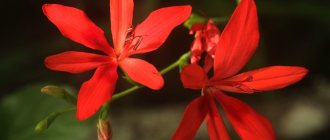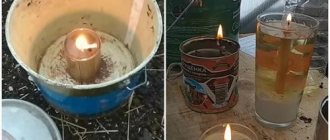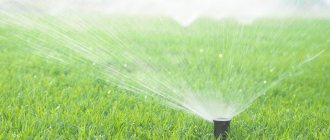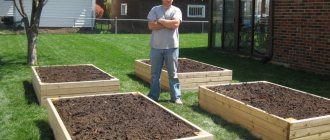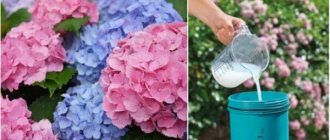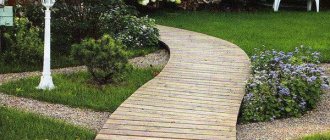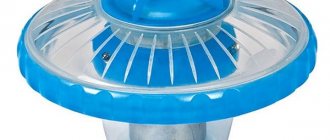Daisies are a beautiful perennial plant. If translated from Greek, the name means “pearl”. White or pink flowers form a beautiful border in a flower bed. They bloom in April and until July. Terry varieties and tubular varieties are very beautiful.
In the first year, this plant develops a beautiful rosette of spade-shaped leaves. And in the second year, flower stalks develop, their height is 20 cm. It has large inflorescences, white, red and pink. There are 7 types of daisies in total.
Brief characteristics and description of the flower
Daisies can be grown in any garden soil, but all varieties of daisies need humus-rich soil that contains lime. They feel good both in the sun and in the shade. They tolerate winter well and retain buds and leaves under a layer of snow.
Old plants gradually degenerate and therefore need to be dug up and divided into parts. It is better to do this in the summer, after flowering has passed.
It can be propagated by cuttings, dividing the bush and seeds. When propagated by seed, strong plants will grow that produce abundant flowering.
They are grown through seedlings in boxes, or sown in the ground from May to July. They are planted in a permanent plot at the end of summer. They begin to bloom after a year and last for 2 months.
Cuttings should be done in May. Cuttings take 2 weeks to root.
You need to water regularly and abundantly. If the plant has a tall stem, then you need to make a support.
Wild daisies are used to treat illnesses. To do this, the plant is dug up during the flowering period. For example, as an appetite stimulant, in the treatment of liver diseases, and generally as a blood purifier.
The most famous varieties:
- Snowball. The flowers are pure white, dense double flowers.
- Etna. This species has spherical inflorescences of red color.
- Pomponette. This variety has beautiful pink flowers.
Types and varieties of perennial daisies with descriptions and photos
There are about one hundred species of perennial daisies. They differ in the following ways:
- according to the height of the crop. Height varies from 2 to 30 cm;
- according to the structure of the flower. It can be reed or tubular;
- according to the shape of a flower. It comes in the form of a ball, daisy, pompom, rose;
- by the type of petal color. There are single-colored ones, with varying degrees of color on the upper and lower sides, with stripes, with spots. The color varies from snow-white to bright red;
- by the appearance of terry. There are plants with simple, double and semi-double flowers;
- according to the size of the inflorescence. Flowers are small from 1.5 cm in diameter, medium from 4 cm in diameter and large from 6 cm.
In addition, varietal daisies differ in the time they begin to bloom: early and late flowering.
Among the abundance of varieties and types of flower crops, we can still identify the most popular among gardeners. Thus, double and semi-double varieties and hybrids of perennials are mainly cultivated.
The most beautiful varieties of daisies with names and photos:
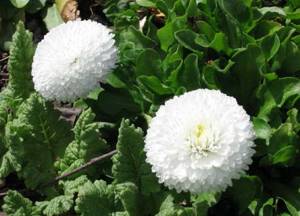
Daisies variety White ball photo and description
“White ball” - plant height 15 cm, double flowers, pure white.
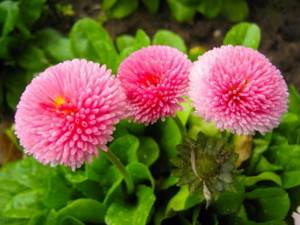
Daisies variety Pink ball photo and description
“Pink ball” - plant height 15-20 cm, double flowers, carmine pink.
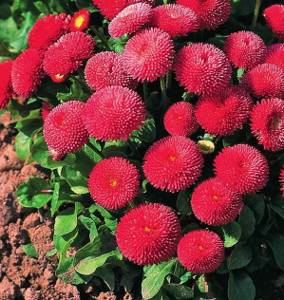
Daisies variety Red carpet photo Growing and care
“Red Carpet” - plant height up to 20 cm, double dark red flowers.
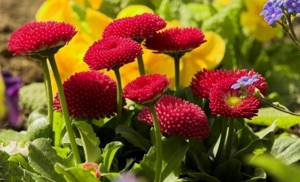
Daisy variety Etna photo in the garden
"Etna" - color of flower petals: orange center and dark purple edges.
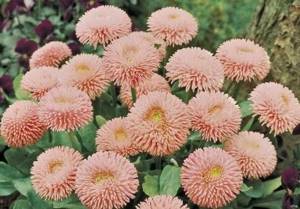
Robella daisies photo in the garden
"Robella" - color of flower petals: coral combined with red. Balcony varieties with abundant and long flowering are also in demand. "Early Etna", "Dresden China", "The Pearl" are compact plants suitable for forcing in winter and early spring.
Daisy - perennial flower, cultivation and care in the garden
Daisy is a representative of the Astrov family, originally from Mediterranean countries. A perennial, low-growing plant with small, brightly colored flowers of various shades. In the wild it blooms only with white flowers; the variety of shapes and colors is achieved through selection.
Daisies are unpretentious, they are used to decorate the garden; the plant looks decorative and is pleasing to the eye.
Features of the plant. From Greek, daisy is translated as “pearl” and there is confirmation of this. In the wild, small white daisy flowers look like real pearls among the thickets of grass. Daisies are low-growing (no higher than 30 cm) perennials, grown as biennials, since the bush requires rejuvenation.
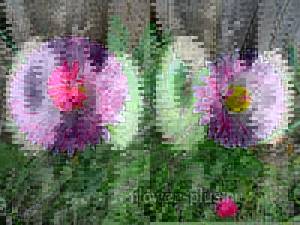
Their leaves are juicy, bright green, collected in a compact rosette. The peduncles are low, the flower has the shape of a basket with a yellow core. Double and non-double varieties of various colors have been bred, decorating the flowerbed all summer and early autumn.
Landing. Daisies begin to be planted on the site no earlier than June, since in May there is a possibility of frosts that can destroy young plants. Daisies are planted in three ways: seedlings, direct sowing of seeds in the ground, or dividing the mother plant.
When planting, it is necessary to maintain a distance of 10-15 cm between holes and rows, and do not bury seeds and seedlings.
Seed material for seedlings is prepared in advance: around April, you can sow daisy seeds in light and loose soil. It is better to place the container with seeds in a warm and bright place; shoots appear in 7-8 days.
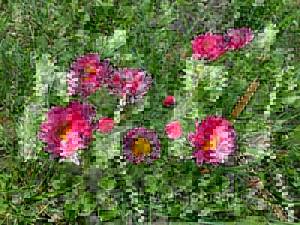
Plants grow quickly, so after a month they require picking or immediately planting in open ground. By direct sowing into the ground, daisy seeds are planted in early June, choosing a place on the east side, without direct sunlight during the day.
The soil should be rich in black soil and free of clay, since daisies do not like stagnant water. The seeds germinate quickly and require thinning, the distance between plantings is at least 15 cm. The plants will bloom only in the second year.
By dividing the bush, overgrown daisies are planted in the third year of life, since the mother bush ceases to look decorative and the flowers become smaller. Up to 12 new ones can come out of one bush. The old bush is dug up and the plants are carefully separated with pruning shears, sprinkling the sections with crushed coal.
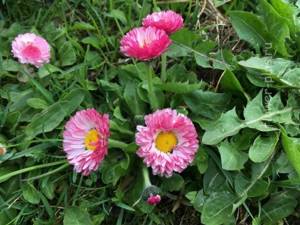
The delenki can be immediately planted in the flowerbed.
Care. Daisies are unpretentious; care consists of regular watering, loosening the soil and removing faded inflorescences. Daisies growing on the sunny side must receive more moisture, otherwise their leaves will begin to wither. In the sun, flower stalks are shortened, so it is preferable for daisies to be planted in places where there is slight shading during the midday hours.
It is advisable to loosen the soil after each watering, since the plant does not tolerate stagnation of water and loves when air penetrates to the roots. Fading baskets take moisture and nutrients from the plant, which can lead to the shredding of other flowers on the bush. It is better to remove old flower stalks.
If seeds are needed, then it is better to leave several flowers until they dry completely and only then collect the seed. Store daisy seeds in a paper bag in a dry, dark place. Many winter-hardy varieties of daisies have been developed that can survive the winter without shelter.
In general, daisies, due to their short stature, winter well under the snow, but it would be better to cover them with fallen leaves for the winter.
Fertilizer. Fertilize daisies 3 times per season. In the spring, when the snow has melted, nitrogen fertilizer is applied to the flowerbeds with daisies, which gives strength and nutrition to the growing flowers that are gaining flower stalks. In mid-summer, the flowerbed is fed with phosphorus-potassium fertilizer, which stimulates flowering.
Before applying fertilizer, it is recommended to cut off all the flowers - the plant will bloom a second time in September. The third time, any mineral fertilizer that supports the bush is applied. Diseases and pests. Daisies are not susceptible to disease or pest infestation; powdery mildew is only occasionally found on the plant.
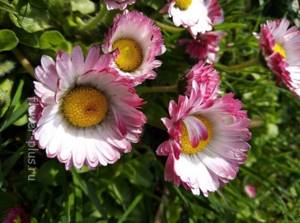
At the first signs of disease, daisy leaves should be sprayed with a special product or garlic tincture. When spraying, try not to get it on the flowers. In summer, slugs and caterpillars are not averse to feasting on daisies. To get rid of pests on the site, chemical means of protection are needed.
Beneficial features. These beautiful flowers can not only please the eye, but also bring health benefits. The simplest recipe is a salad of young daisy leaves; they are edible and high in vitamins.
Daisy can help with diseases of the respiratory system, digestion and skin diseases. It is believed that daisy juice strengthens the body. Use in landscape design.
Daisies are combined with low plants; they are used to create mini flower beds and garden paths. Thickets of daisies over a large space can look like a carpet of flowers. With proper care, the daisy will bloom magnificently and beautifully all summer long. Due to the variety of varieties, daisies with tall peduncles are used to make bouquets.
Small, beautiful pearls - daisies - never go out of fashion; they are a symbol of tenderness, purity and beauty. Legends are made about them and unmarried girls make fortunes about them. The daisy in the garden will definitely attract admiring glances, thanks to its amazing bright flowers.
Growing daisies
Although the daisy plant is a perennial plant, after the age of two years it loses its beauty.
As a result, it is worth dividing the bushes or completely removing them and planting new ones. Frost-resistant varieties can be used for many years without replanting. They can be a nice backdrop to a grassy carpet.
Low frost-resistant varieties are often used to form rectangular flower beds or in artistic stripes along garden paths. Together with the daisy, different flowers are combined in one flowerbed.
Over time, the bushes grow and need to be thinned out, and the removed parts can be planted in another flowerbed. The maximum height of a daisy stem is 30 cm, the minimum is 10.
Therefore, you can buy perennial daisies of low varieties to create borders, to decorate the foreground of a flower group. There is experience in growing daisies in flower pots and hanging plant pots.
Daisy produces a large number of small seeds, the germination rate is quite high. When buying perennial daisy seeds in stores, you don’t have to worry about the results of planting. Since even if stored for five years, the seeds will give good results.
When and where to plant
By the second half of June, it is already worth taking care of planting the plant; the seeds are sown immediately in open ground. But you should choose a place not in the sun. A slightly shaded space or where the sun doesn't hit all day is best.
If there is a need to plant in an open sunny area, then there must be regular watering to maintain the required level of moisture.
Growing daisies from seeds
Despite this, excessive humidity should not be allowed. The land must have good throughput. It is important that moisture penetrates to the roots when watering.
Landing sequence:
- the first thing you need to do is loosen the ground, clear it of weeds;
- very small furrows up to 1 cm deep are prepared for seeds, the distance between such strips is up to 5 cm, they must be moistened;
- sow;
- the seeds are covered with a thin layer of sand, earth or humus, the seeds should be warm and light;
- Now the main job is watering twice a day strictly from a spray bottle.
It is very important at the time of planting and after that not to allow the soil to dry out, otherwise the seeds will not sprout.
If you constantly moisten the soil, then growing a perennial daisy will not be a difficult process; sprouts will appear on the fifth day after planting. Then the growth process slows down. The frequency of watering the plant after exiting remains the same.
After some time, the flowers will quickly grow. Here you need to seize the moment and plant when the sprouts begin to connect, at a distance of about 20 cm. This way the plant has the opportunity to grow. As a rule, the procedure occurs in the month of August.
Already in the fall, strong compact bushes are formed, which will delight you with flowering next year.
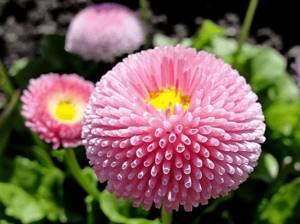
Growing seedlings
If you don’t want to wait for flowers until next year, then you need to plant perennial daisy varieties in the form of seedlings.
Seedlings are prepared in the same season:
- at the beginning of spring you need to sow the seeds; any light substance will do;
- the seeds are sown in rows in moistened soil, lightly sprinkled on top and pressed, watering must be done through a spray bottle;
- the box with seeds should be at a temperature of about 20 degrees, the soil should be constantly moistened;
- in a week or two new shoots will appear, moisturizing cannot be stopped;
- After another 2-3 weeks, leaves will appear and the plant can be picked;
- seedlings should receive maximum light so that they do not start to grow sharply upward in search of it;
- before planting in open ground, you need to harden off the seedlings, as usual;
- planting occurs in May - June.
How to plant daisies in open ground?
Daisies are undoubtedly loved by most gardeners. Even an inexperienced person can plant and care for them. There are many varieties of daisies to suit everyone's taste. But the question often arises, where is the best place to plant these wonderful flowers.
Gardeners in our country prefer to grow flowers from seeds at home, about 2 months before flowering. It is important that the air temperature does not fall below 21 degrees Celsius; if the conditions are met, the first shoots will soon appear.
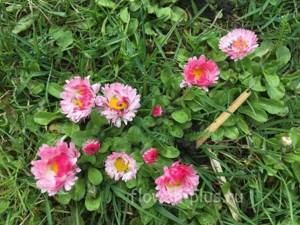
After the first leaves have formed, it is necessary to pick out future flowers and, after some time, plant them in a permanent place.
Let's start planting it in a permanent place. Daisies need sunlight to actively grow and bloom. It follows from this that planting should be done on the side of the site where ultraviolet rays easily penetrate.
They are not picky about the soil; any open ground will do. The only condition is good impregnation of this soil with fertilizers. Under no circumstances should these flowers be watered abundantly; if the soil is too dry, this will not be as bad as an excess of moisture. A drainage system is also welcome in planting areas. To prolong the life of inflorescences, it is better to remove fading baskets.
How to collect your seeds
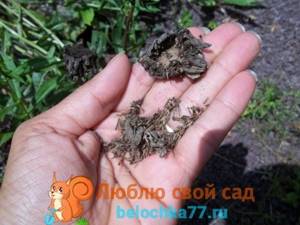
Tubular and double varieties produce few seeds. When propagated by seed, they produce many simple forms. To obtain decorative flowers, plants are propagated by dividing the bush and cuttings.
Seeds from other varieties should be collected as the inflorescences wither. The inflorescences are removed from the bush and dried on a sheet of paper. The inflorescences are laid out in a thin layer. When dry, they become dry to the touch. The seeds become light gray in color.
The collected seeds are sifted from the petals and scattered into paper bags. They are stored in a dry and cool place.
Seeds remain viable for 2-3 years.
If the seeds are not collected on time, they scatter on the ground and in the spring many shoots appear, which are resistant to cold, but when flowering the buds become smaller, the decorative effect is most often lost.
Flower care
Daisies require minimal but no less important care. We must not forget about weeding the land and fertilizing it. After watering, a mandatory part is loosening the soil in the root area. You can carry out the procedure of mulching the soil.
Mulching is covering the soil with mulch (compost, organic matter) to protect and improve it. This procedure will help maintain the health of daisies; thanks to this method, loosening, watering and getting rid of weeds can be reduced.
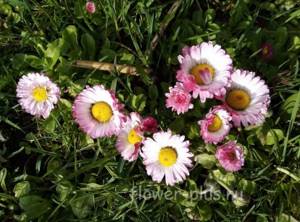
All this is explained by the fact that moisture is retained under this layer of mulch, and weeds are extremely rare. These flowers are little susceptible to disease; they are affected by powdery mildew and gray rot. If you notice that the leaves are starting to rot, then simply spray the plant with garlic tincture and immediately remove the affected flower.
It happens that the bushes become white and the flowers become small; immediately remove the specimens along with the soil. Daisies look lovely everywhere, the main thing is to follow the rules of care, then you will be happy with a lawn with these flowers for a long time.
They need to be weeded, loosened and watered. Apply mineral fertilizers, phosphorus and potassium. Faded inflorescences must be removed, which will ensure abundant and long-lasting flowering of the plant. Daisy is a frost-resistant plant.
Caring for daisies in the garden
Growing conditions
Growing daisies does not require extra effort from you; it involves watering, loosening the soil, weeding and fertilizing the plants. Since the root system of daisies is shallow, watering the plants must be regular, otherwise, due to lack of moisture, their inflorescences become small, and double varieties lose this quality. After watering, you need to carefully loosen the soil around the plants to improve root aeration.
If you mulch your daisy patch, you won't have to loosen the soil or fight weeds as often, and you'll also be able to water your daisies less often because mulch keeps the moisture in the soil from evaporating too quickly. In addition, mulch is a preventive measure against the phenomenon of bulging roots, which occurs as a result of the drying of the top layer of soil.
- Buzulnik: planting and care, types and varieties
As for fertilizing, they need to be applied at least twice per season. For 1 m² you will need 25-30 g of complex fertilizer for flowering plants with microelements. Also remember to remove spent daisy blossoms to prolong flowering and ensure quality.
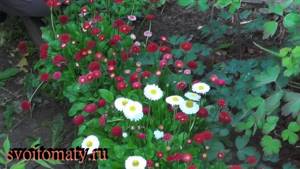
Reproduction of daisies
In addition to the seed method of propagating daisies, garden floriculture also uses methods of vegetative propagation - dividing the bush and cuttings. Vegetative methods are needed primarily in order to preserve valuable varieties of daisies, the flowers of which begin to become smaller with age and lose their decorative properties.
Bushes are usually divided in late summer or early autumn, although this can also be done in spring. The bush is dug up and divided into 4-6 parts, after pinching all the formed flowers and buds, cutting off all the leaves from the petioles and shortening the roots to 5-8 cm in order to increase the ability of the divisions to take root in a new place. Then the cuttings are planted in the ground, where they quickly take root and continue flowering. If some cuttings turn out to be without roots, there is nothing wrong with that: plant it in the ground, and new roots will grow from the base of the leaf cuttings of the daisy.
When cuttings, at the same time period, with a sharp knife, side shoots with leaves are separated from the daisy bush and planted in beds with loose soil, where they take root within two weeks. Daisies from cuttings will bloom next year.
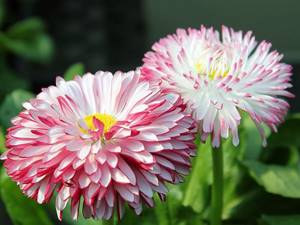
Pests and diseases
Small daisies are surprisingly rarely affected by both pests and diseases, but the danger of being affected by a viral disease still exists: sometimes at the beginning of summer, the stalks of plants begin to stretch out, the inflorescences become small, and the leaves become smaller and turn pale. If you notice such changes, you must immediately burn the diseased specimens along with the root system, and disinfect the place where they grew with a strong solution of potassium permanganate.
There are cases of powdery mildew disease of daisies, from which a white or grayish loose coating spreads over the leaves and flowers. The fungus can be destroyed by treating all plants in the area with a solution of colloidal sulfur, Topaz or Bordeaux mixture, and it is better to remove and burn diseased specimens or their affected parts.
Sometimes daisies suffer from mites, which are destroyed by treating them with an insecticide, for example, Karbofos or Actellik. Mice also harm daisies, and you can fight them by placing bait with poison around the area. Despite these troubles, which may not happen to your flowers with proper care, planting and caring for daisies can be considered more of a pleasure than work, especially since daisies will thank you for a little effort with long and beautiful flowering.
- Eleutherococcus
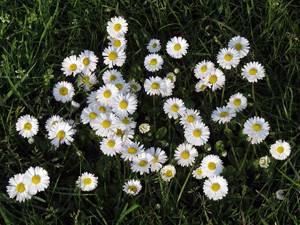
Methods for propagating daisies
The daisy is a bright and at the same time delicate flower. Translated from Latin it means “beautiful”, “wonderful”.
A perennial plant, unpretentious and not requiring much attention. Widely used in landscape design. They can be a wonderful decoration for alpine slides, flower beds and flower beds.
There are 2 main ways to propagate daisies.
Generative method (seeds)
Sowing is carried out from the beginning of May to the end of June. Directly into open ground, which must first be fertilized and drained. The soil should be loose and light. The most suitable location is in partial shade.
When placing a flower garden in a sunny place, constant monitoring of soil moisture is necessary until sprouts appear. But the daisy does not tolerate constant waterlogging. The seed placement depth is small.
The optimal solution would be to spread the seeds on the ground and sprinkle earth, sand or humus on top. If you plant the seeds too deep, the crops will not receive enough sunlight and temperature. If all conditions are met, the first shoots will appear in 7 days. After this, it is necessary to pick the seedlings according to the 20*20 pattern.
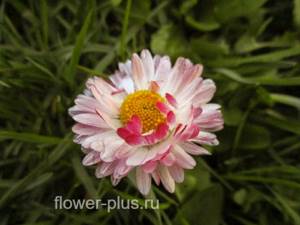
At the same time removing all weak shoots. Flowering will begin only next season. During this time, the plant will grow its root system and foliage. You can grow a daisy using the seedling method - sow the seeds not in open ground, but in a container with a nutrient substrate.
Sowing is done in February-March. It is recommended to use individual containers so as not to injure the seedlings when picking. Growing conditions are the same as for sowing in open ground.
Daisies have the ability to abundantly self-sow - the ability of a plant to reproduce on its own.
In spring, many young plants appear near the mother bush. In this case, you do not need to plant anything, but only thin out the rows of daughter plants. Although this method of propagation is simple, it negatively affects the brightness of the color and the size of the flower.
In addition, varietal qualities and terryness are lost. To avoid unwanted self-seeding, it is necessary to periodically cut off faded flowers. About once every 2-3 days and as needed.
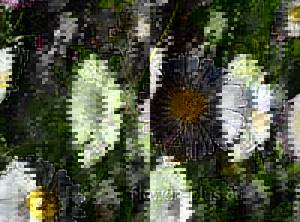
You can collect the seeds yourself and then use them for further propagation. In order to produce high quality planting material, it is necessary to adhere to certain rules:
- Inflorescences suitable for collecting seeds are collected on a warm, windless day in the evenings, every 2-3 days;
- The collected flower baskets are dried in natural conditions. To do this, they need to be laid out on a sheet of paper in a thin, even layer;
- The drying process lasts until the grains spontaneously release from the inflorescence basket;
- The material obtained during drying is sorted and placed in paper packaging. Each package indicates the name of the variety, date of collection and color of the plant;
- It is recommended to store the seeds in a dry and cool place.
If you follow all the above points, you can get high-quality seeds that remain viable for up to 3 years. But when propagated using this method, there is a possibility of losing the uniqueness of the variety.
Vegetative method
This method is capable of maximally preserving the high varietal qualities of the plant. The peculiarity of daisies is that after several seasons of flowering, the flowers begin to degenerate - become smaller and lose their marketable appearance.
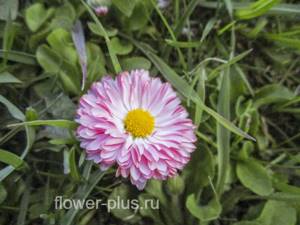
But with periodic use of the growing season, you can preserve the extraordinary beauty of this plant for a long time. Bushes older than two years are subject to vegetation. Thus, new plants have a better chance of surviving the winter without dying.
In vegetative propagation, two types of division can be distinguished:
Division by bush.
Usually produced in August-September. To do this, you need to remove the bush from the ground and carefully divide it into several parts. Be sure to inspect each root for diseases.
To make the separated part easier to take root, you need to cut off all the flowers, buds, and leaf blades, leaving only the cuttings. The roots themselves are shortened to 50-80mm. Then plant all the cuttings, deepening to the very leaves.
It may happen that one of the separated parts of the bush will be left without a root. But this does not mean that it is unsuitable for planting. This part is capable of growing a new root system.
Adaptation of the divisions occurs quite quickly. After a while, young leaves begin to appear on them. This means that the rooting went well.
By cuttings.
Held in May-June. To do this, you need to cut off the side shoots with leaves from an adult bush using a sharp object. Treat the cut area with activated charcoal or charcoal.
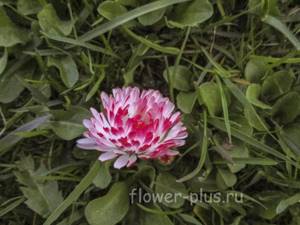
This will help disinfect the exposed surfaces of the plant. Then plant the separated part in a flowerbed with previously prepared loose soil and cover with non-woven material. It is advisable that the place be in openwork shade. New cuttings will take root completely after a couple of weeks. The plant will begin to bloom only next spring.
Each of the listed methods of propagation of this plant is very effective. But if we are talking about a valuable variety, it is wiser to use the growing season method. With proper care, the daisy will become a “pearl” in any garden and will delight the eye for many years.
Plant varieties
Daisies are grown as annuals and perennials.
Growing daisies in open ground from seeds - video
In the process of care and breeding there is no particular difference between daisies. It is clear that, for example, an annual plant will not need shelter for the winter. And it makes no sense to propagate it vegetatively.
Annual daisies
Bellis annua can be successfully grown not only in open ground, but also in balcony boxes or on the terrace.
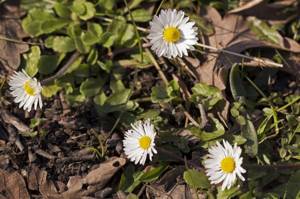
Perennial daisy
Bellis perennis consists of a rosette of leaves, where each plate is oval in shape. The height of the bush reaches 10-30 cm. In the second year of life, many shoots with flowers appear from the leaf rosette. The shoots are slightly pubescent. The color of the buds can be burgundy, white or pink. According to the structure of the inflorescences, perennial daisy flowers are divided into tubular and reed. The seed is flat-shaped and small in size.

Simple-shaped flowers are distinguished by single-row or three-row arrangement of reed-shaped or tubular-shaped petals.
In the central part of the flower there is a disk with tubular yellow flowers.
The semi-double form of the flower forms more than 4 rows of petals. The yellow core is also present.
Flowers of a double structure are endowed with so many rows of petals that hide the yellow core.
Based on the size of the inflorescence, they are divided into small, medium and large buds. Large flowers exceed 60 mm, while small ones barely reach 20 mm.

Popular varieties of daisies:
- "Rob Roy"
- small bushes with red flowers from 10 to 20 mm in diameter.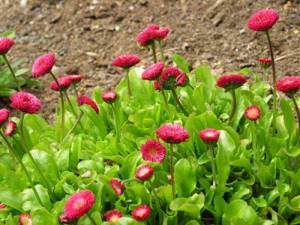
- "Robela"
- medium bushes with double flowers up to 50 mm in diameter. The pink-salmon color of the buds is very attractive to gardeners.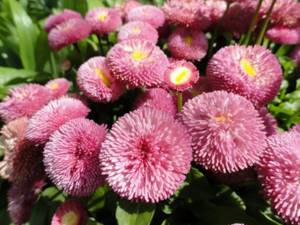
- "Bella Daisy"
- bush of medium height. Belongs to early flowering. The size of the pink flower is 25 mm.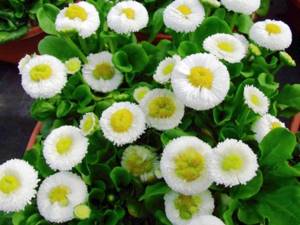
- "Pomponette"
- a small bush with small pompom-shaped flowers.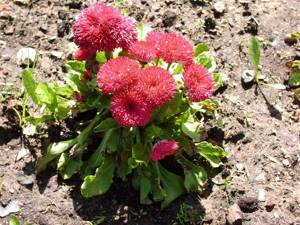
- "Habanera"
variety with large flowers of white, red or pink color. The most striking daisy from this series is White Visa Red, with white petals and a red border.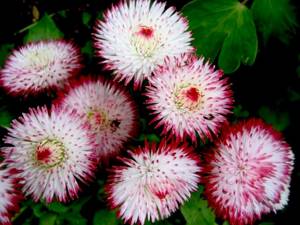
- "Galaxy Mix"
a bush with a snow-white, yellow or pink basket, where one flower reaches 5 cm in diameter.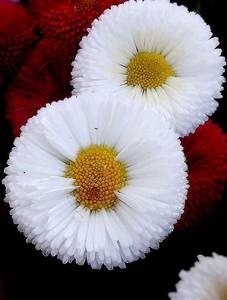
- Daisy "Tasso"
- a plant with beautiful tubular flowers, 4 cm in diameter. The color of the buds ranges from salmon to scarlet.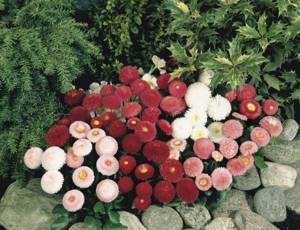
- "Rominette"
bushes with double flowers, not exceeding 2 cm in diameter. The color of the pompom buds is white, carmine or pink.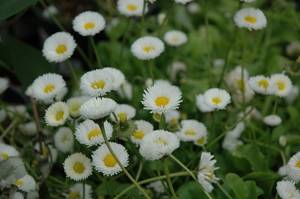
- "Speedstar"
daisy with semi-double flowers. The color is white or carmine with a bright yellow core.
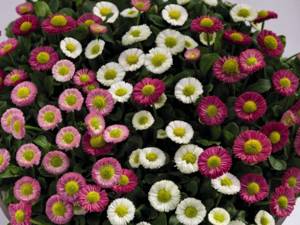
Dwarf or miniature daisies are in little demand, but they also have their admirers. They are often grown in small gardens and receive special attention. If you neglect the rules for caring for miniature plants, they will, after some time, become overgrown with weeds and remain invisible.
These varieties are:
“Dresden China”, “Lilliput”, “Alice”.
Photo of daisy "Dresden China"
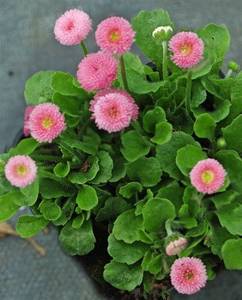
Photo of daisy "Liliput"
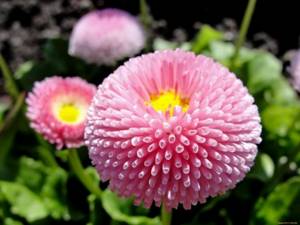
An interesting fact is that dwarf varieties of daisies are planted in English parks.
There, the plants grow generously and are even mowed with lawn mowers, without harm to the general condition of the plant. On the contrary, such procedures additionally stimulate the little ones to flower.
It will be useful for flower growers to know that daisies do not tend to grow longer than 3 years.
When this age is reached, the plant stops blooming or simply dies. It was also noted that varieties with large inflorescences begin to bloom much later than their relatives. But large baskets of such daisies promise to please gardeners longer.
In the garden, daisies create a beautiful sight. These miniature bushes evoke reverent and tender feelings in many gardeners. They can be combined with various plants. For example, they will perfectly coexist with dwarf varieties of asters, primroses, marigolds, etc.
How to plant daisies with seeds for seedlings?
Margarita is a very beautiful and popular plant. Interestingly, in some countries it is called the “eye of the day.” Residents of Foggy Albion affectionately call it Daisy, because in England it is called “dais eye”.
And girls in Germany used it to tell fortunes like daisies, and there it is called “the measure of love.”
There are several ways to grow this flower:
- You can grow a daisy by sowing seeds in the ground. At the same time, it will grow for 2 years.
- You can grow annual daisies from seeds.
- You can grow two-year-old daisies from seedlings in just a year. Let's talk about this method.
Let’s first consider how to plant them, and then we’ll talk about the subtleties.
First of all, the earth must be heated in the oven and cooled. Afterwards, it is recommended to transfer the soil, for example, to a container and water it generously. Only after this can you start filling in the seeds (they, by the way, are very small), then close the lid of the container.
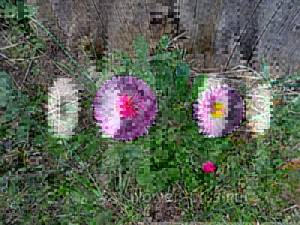
And leave it to grow for 20 days. After the end of the period, when it begins to grow and leaves appear, you can begin to dive. After diving, water generously again. Planting - that is, transplanting seeds to another place to improve plant growth.
This method can be quite difficult, so it should only be used for commercial purposes. And at home it is very difficult to achieve the necessary suitable conditions. They should be planted in late September - early October, and they need to be provided with additional lighting.
A day for them should be approximately 13 hours long. In terms of its structure, margarita is a biennial plant, so you will have to try hard to make it grow in a year. First you need to plant it in open ground (and it is advisable to choose good, nutritious ground), the lump of which is not touched and the root system is as intact as possible.
Therefore, it is recommended to first plant it in a container or box, and then dive it, for example, into glasses. It is also recommended to use greenhouses to maintain soil and air moisture.
How to plant daisies in spring
The name of this flower sounds in ancient Greek as “margarites”, which translates as pearl. And this is about daisies - delicate scatterings that will decorate any area.
Low and herbaceous, they belong to the Asteraceae or Asteraceae family.
And belonging to perennials also determines the method of reproduction, there are several of them:
- Division.
- Cuttings.
- Growing from seeds.
But if you want to achieve flowering this year, then it is better to plant daisy seedlings in advance. It would be more correct to sow in February or March, preferably in a separate pot.
What is needed for planting?
Plant the seeds shallowly and sprinkle with a light layer of sand. Abundant moisture and daylight for 14 hours will ensure healthy seedlings.
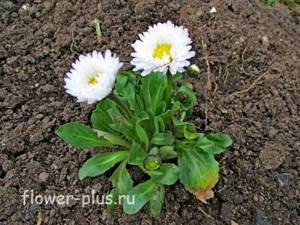
And 2 weeks after the first shoots, the temperature can be gradually reduced to +15C. This is done in about a week to prepare the “young animals” for transplanting into open ground.
If there are several seedlings in one container, the seedlings do not dive. The roots of daisies develop in width and are easily damaged during transplantation.
Where is the best place to plant?
When choosing a place for seedlings, pay attention to a well-lit area. Since flowers obscured by a bush or tree will not perform well.
In general, they can grow well in open areas and in some shade. Based on their further decorative functions, be prepared for the fact that you will have to adapt the soil in the selected area.
The plant itself is unpretentious; it will feel comfortable in any soil, regardless of its composition. The exception is acidic or alkaline soils.
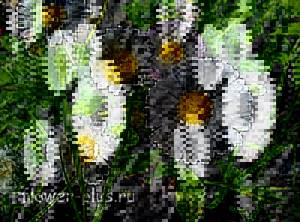
Therefore, experienced summer residents advise choosing light loam. The place is covered with film to create a greenhouse effect. You can remove it after 2-3 days.
Remember: the appearance of puddles in the area where seedlings grow is not desirable, and if it is lowland, then you should take care of the drainage system in advance. However, regular watering is required. Their roots are on the surface and if the soil dries out, they can easily become damaged.
The optimal time for planting is April-May or early June. To avoid night frosts.
The young plants are lowered into open ground using the transshipment method, and if the seeds came out in peat pots, along with them.
The gap between two bushes must be maintained at 15-20 cm, taking into account the further growth of the roots of the plant.
Growing daisies from seeds When to plant seedlings
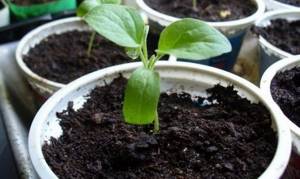
Growing daisies from seeds photo seedlings
When to sow daisy seedlings? If you want the flower to bloom earlier, you need to sow the seeds in February-March. It is better to plant seeds in separate containers. Pots made of paper, plastic or peat are suitable. In this case, if one or two plants have sprouted in a pot, you don’t have to pick them. If you use a large container for planting seeds, the grown plants will dive.
Seedlings grow well and do not get sick if the soil does not dry out and daylight hours last up to 14 hours. That is, it is necessary to ensure that the “young animals” are illuminated. Two weeks after the sprouts appear, reduce the temperature at the location of the plants to +15ºC. And the middle or end of May (7 days before planting the seedlings in the ground) is the time to harden the plant.
- You need to sow in a common container on top of moistened soil as little as possible, lightly sprinkle sand or earth on top. Be sure to make drainage holes in the bottom to prevent the plants from getting sick.
- The container is covered with a transparent lid or plastic bag to create a greenhouse effect, and ventilated daily.
- After the shoots appear, the cover is removed.
- Continue care with moderate watering and provide good lighting.
- Seedlings are planted when a pair of true leaves appear in separate cups.
- They begin to harden off a week before planting, leaving the seedlings outside for a short time at first, then more, up to a full day in the last days.
You can plant daisies in April-May, when there are no night frosts.
The video will tell you how to sow daisies for seedlings:
Daisy: myths and legends about flowers
Daisy translated from Latin means beautiful, and translated from Greek means pearl.
Russian fairy tales and legends speak very touchingly about daisies. Thus, in the fairy tale “Sadko” it is described how his beloved
Lyubava ran towards him until the thread of the pearl jewelry broke and the pearls rolled on the grass. And the pearl beads turned into daisies. Indeed, small daisy flowers look like pearls on lawns.
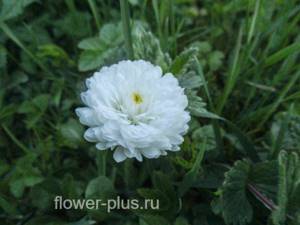
People call the daisy differently: asterisk, eye of the day, hundredfold, measure of love. All this corresponds to the appearance of the daisy: it opens with the first rays of the sun, has numerous petals on which lovers tell fortunes.
Thanks to the parable, the daisy is called the “child’s flower.” It tells about a little girl who asked the stars to become flowers.
The stars, as if in a mirror, were reflected in drops of dew and turned into daisies.
They covered the entire meadow in front of the girl's house. Then the sun asked the flower in the morning: “What else do you want?” To which she replied: “I’m very happy.” Just let me bloom all year round. I am so happy when children play with me. I want the happiness to never stop.
The sun touched the flower with its ray, and a yellow spot remained in the middle.
There are many legends about the appearance of daisies on earth. Thus, in one Christian legend about little Jesus, during winter the Most Holy Theotokos decided to console him with flowers and sewed small daisies from silk. While she was sewing them, she repeatedly injured her fingers with a needle.
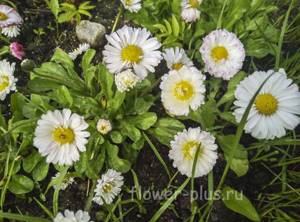
Why did droplets of blood remain on the flowers? Jesus liked the flowers very much, and when spring came, he planted them in the ground. Daisies came to life and began to bloom all over the earth.
But there are also sad tales about these flowers. A long time ago, a middle-aged rich man fell in love with a beautiful girl. He presented her and her parents with expensive gifts. But she could not stand him and asked the earth for help. And the earth helped the girl by turning her daisy.
In one of the legends, Countess Margarita gave a white carnation to her fiancé, knight Orlando, who was leaving on a military campaign. Orlando died, and his comrade found on him a lock of Margarita’s hair and a dried flower stained with his blood, which he gave to Margarita. Seeds have already formed in the flower, and
Margarita planted them as a memory of Orlando.
There are interesting facts about this flower. In the 18th century in Germany, the daisy was declared poisonous. Throughout the country it was decided to exterminate it. But no matter how this flower was destroyed, it remained to live on the earth.

